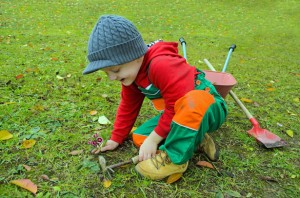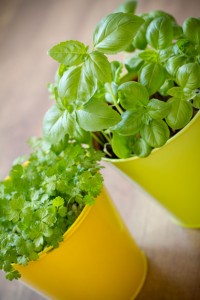Gardening with young children is another powerful activity for fun, learning, kindergarten readiness and connecting to nature. Digging in the dirt and planting seeds are definitely hands-on sensory experiences. Yesterday’s blog post talked about getting the soil ready for planting. Once that’s done, it’s time to pop in the seeds.
 Patience is not all that strong yet in kids, so it helps to have seeds that grow quickly so there is something to see. Just like Jack in the Beanstalk, bean seeds are almost magic and in only a few days will have something poking out of the ground. Sunflower seeds are also fast growing and over the summer will seem to be stretching high into the sky. Another advantage of beans and sunflowers is the seeds are big enough for little hands to plant one seed at a time. One finger on a small hand makes a hole just the right size for seeds this big. Corn is also easy to plant and is a good companion seed for beans. The beans can wind up the corn stalk. Pea seeds are recognizable as peas and also like to climb.
Patience is not all that strong yet in kids, so it helps to have seeds that grow quickly so there is something to see. Just like Jack in the Beanstalk, bean seeds are almost magic and in only a few days will have something poking out of the ground. Sunflower seeds are also fast growing and over the summer will seem to be stretching high into the sky. Another advantage of beans and sunflowers is the seeds are big enough for little hands to plant one seed at a time. One finger on a small hand makes a hole just the right size for seeds this big. Corn is also easy to plant and is a good companion seed for beans. The beans can wind up the corn stalk. Pea seeds are recognizable as peas and also like to climb.
 A recent guest on Learn and Play with Mrs. A, Barb McMahon from Sprouting Chefs, suggested that herbs are a good choice for kids to plant. Mint, parsley, and basil are quite touchable and kids can be shown how to carefully pick off just a few leaves that can be added to many recipes. Planting herbs in pots, inside and outside, contains them because they spread.
A recent guest on Learn and Play with Mrs. A, Barb McMahon from Sprouting Chefs, suggested that herbs are a good choice for kids to plant. Mint, parsley, and basil are quite touchable and kids can be shown how to carefully pick off just a few leaves that can be added to many recipes. Planting herbs in pots, inside and outside, contains them because they spread.
When children help in the garden, they see how they can impact the natural world. This helps them connect to the environment and develop their nature-intelligence. Talk with your child about how seeds are different sizes, shapes, and colors and only sometimes give a clue about what they are. Plants certainly give all of us an opportunity to practice being patient. The whole cycle of seed to plant to seed takes a long time, but it is repeated every year. These experiences are all part of learning that will last a lifetime. What will you and your child plant?
